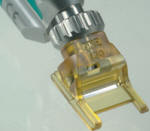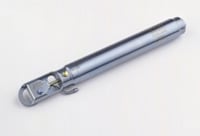Epi-LASIK Coming on Strong
Surgeons with experience discuss early results and how this procedure might fit in.
BY JOHN PARKINSON, ASSOCIATE EDITOR
Epi-LASIK continues to be a lively topic of conversation among refractive surgeons. New technology has been developed, and more epikeratomes are expected to come to market soon. (For an update on the status of several epikeratomes, see "Epi-LASIK Product Offerings," on the next page.) Early results have been promising, and proponents point to the procedure's potential for fewer complications compared with LASIK and faster healing times compared with other forms of surface ablation. While epi-LASIK is still too young for definitive statements about its long-term role, some surgeons suggest it could be a significant, maybe even a dominant, tool in refractive surgery.
Compiling a Body of Data
Research is limited for the moment, as several doctors working with various epikeratomes are in the midst of compiling data. As such, evidence about epi-LASIK and comparisons with PRK, LASEK, and LASIK are mostly anecdotal. One area of interest that could be an influencing factor in the near future is the relationship between epi-LASIK and wavefront-guided ablations. Barrie Soloway M.D., is presenting data on the subject at this year's annual meeting of the American Society of Cataract and Refractive Surgery in Washington, D.C. He says approximately 50% more people have reductions in higher-order aberrations after wavefront epi-LASIK than after wavefront LASIK. Dr. Soloway has been using Moria's Epi-K epikeratome.
Experience and Insights So Far
In light of ongoing developments, Ophthalmology Management asked several surgeons to discuss key aspects of the procedure:
Patient selection. Arturo Chayet M.D.'s biggest group of candidates for epi-LASIK are patients with thin corneas. He prefers not to perform LASIK on patients who have less than 500 microns of central corneal thickness. He also sees patients with moderate dry eye as good candidates for epi-LASIK. For his procedures, Dr. Chayet has been using the Epi-K.
According to some surgeons, patients who shouldn't undergo the procedure include those with epithelial disease and previous PRK or LASIK. Warren Cross, M.D., cautions doctors about doing epi-LASIK on patients who have had past PRK and LASIK procedures. While he has only done a couple of cases on such patients, he has had some challenges associated with them.
Other doctors, however, have reported success in doing epi-LASIK on previous PRK patients. Nonetheless, Dr. Cross stresses the importance of patient history when assessing potential patients.
Patient education. As far as educating patients on the results of epi-LASIK, Dr. Soloway tells them they may start to notice results in a few days, but it may take as long as a month for their vision to be "really good."
"It's letting them know that they are not going to wake up the next day and see perfectly, which we are currently doing with LASIK patients," he says.
"The patient has to prepare for a slower visual rehab than with LASIK," acknowledges Dr. Cross. "What we've found that works very well is that we tell them that their vision is going to be soft. Their correction in their glasses will be close to 0, but they're perfect. Somehow since the little attachments from the epithelium to the cornea are not optically perfectly lined as they were on an unoperated eye, it takes a while for the vision to get better."
Dr. Cross tells patients their vision is initially going to be a little diffuse, like looking through Saran Wrap, or like being in a swimming pool with contact lenses on. Upon giving patients these expectations, Dr. Cross hears no complaints from his epi-LASIK patients. "The average patient is about 20/30 post-op when they come in. Yet these people think they see very well and none of them complain about their vision," he says. Dr. Cross has been performing epi-LASIK with Norwood's Epikeratome.
With his epi-LASIK patients, Thomas Claringbold D.O., leaves the decision up to the patients about when they should go back to work. Interestingly enough, some of his patients are having good enough visual acuity post-op day 1 to drive to work. Although, he cautions these are short commutes and does not recommend long-distance driving.
Pre-op and Surgery. Dr. Cross believes that in order to minimize post-op complications and pain, surgeons need to be proactive and treat preoperatively. He begins by putting all surgery candidates on 1,000 milligrams of vitamin C orally once the decision to operate is made. They continue this regimen for 4 to 6 months post-op to avoid haze complications.
To alleviate the pain potential, Dr. Cross starts patients on systemic anti-inflammatories pre-op. He prescribes 200 mg p.o. q.d. starting 3 days prior to surgery and continues 3 days post-op. Dr. Cross also uses a unique treatment during surgery. "Almost all pain is inflammatory. You can block down the inflammatory response 2 or 3 days before surgery by starting the patients on anti-inflammatories or straight Motrin q.i.d. Then we do what we call a 'frozen Popsicle.' We place a Weck-Cel sponge with frozen BSS on the cornea for 1 minute immediately after ablation." Dr. Cross reports since using these treatments, none of his epi-LASIK or PRK patients complains of pain.
Drs. Soloway and Cross advise colleagues that the epi-LASIK technique is different from LASIK. Dr. Soloway says that due to the delicate nature of creating an epithelial flap, it takes a little longer -- approximately 15 seconds -- to make a pass.
Dr. Cross warns against gripping the epikeratome too tightly because it could cause the instrument to stop oscillating and damage the sheet. In those rare cases where this occurs and the flap is not viable, he suggests adjusting the procedure to a PRK. "The doctor has to relax and let the instrument float in hand," explains Dr. Cross.
When placing the sheet back during epi-LASIK, surgeons may come across a larger epithelium. "The flaps have a tendency to be a little stretched -- about a millimeter -- so if you put them back stretched and smooth they will overlap the periphery," states Dr. Soloway. He compares it to putting down a rug that is too big for a room and it is bunched up in areas. Dr. Soloway says that in these cases, patients' epitheliums retract back to their natural positions hours after the surgery.
Dr. Claringbold just started using the aforementioned Popsicle treatment for decreasing the epithelial sheet stretching. "I put it right on the leading edge of the flap before we make the pass. It seems to decrease the stretching quite a bit." Dr. Claringbold has used Norwood's Epikeratome, and presently uses Visijet's EpiLift.
Post-op. Dr. Chayet's postoperative medication regimen includes: topical antibiotics q.i.d. for 5 days; nonsteroidal oral pain medications q.d. for 4 days; topical steroids b.i.d. for 4 days; nonpreserved tears as needed; and topical anti-inflammatories b.i.d. for 4 days.
When removing a bandage contact lens post-op, Dr. Cross recommends using forceps as opposed to doing it manually. By doing it with your fingers, he says you could pull the entire sheet off. "The epithelium becomes adherent first where you have done the ablation and tends to be a little less so around the perimeter." His technique for removal begins by hydrating the eye with tears liberally. He then pinches the contact lens with forceps at the 6 o'clock position and slides the lens off.
Epi-LASIK vs. PRK and LASEK
According to doctors, differences between epi-LASIK and other surface ablation techniques are emerging. They acknowledge there is still some pain and recovery time associated with epi-LASIK but say there are slightly fewer complications or pain complaints than with PRK or LASEK.
"It [epi-LASIK] has already replaced PRK in my practice," reports Dr. Chayet. He says epi-LASIK patients seem to be healing a little faster and having less pain than with PRK. He does not perform LASEK due to potential alcohol-related complications. "It [epi-LASIK] is not like LASIK, but it is slightly faster than PRK; it is too early to have strong data about [epi-LASIK]," acknowledges Dr. Chayet.
Dr. Claringbold has been performing LASEK since 1999, and he continues to use it along with epi-LASIK. He is seeing lower levels of pain on a scale of 1 to 10 from epi-LASIK patients as opposed to LASEK patients. He is optimistic about the technology, but he wants further proof.
"It's still real early. There are still a few questions that need to be answered for myself. For somebody who didn't like using LASEK because of the alcohol, then this will rapidly change his or her mind," explains Dr. Claringbold.
His questions include whether patients are more functional and more comfortable during the first week post-op. Early results are very positive. And further down the road, he wants to see if he can get the contact lenses off earlier, because that will lead to real competition with LASIK. For this to happen, Dr. Claringbold says the procedure and pre- and post-op regimen will all have to be standardized.
LASIK vs. Epi-LASIK
Although epi-LASIK may have made some inroads compared with other surface ablation procedures, it still has a way to go before it can be the most dominant method of refractive surgery. "I think we have made significant improvement in terms of the healing time, the pain, the return to good vision as compared to other methods of surface treatment, but it's still not LASIK," explains Dr. Soloway. He says once greater gains are made with healing, specifically an epithelial healing agent, he says recovery times will get better and the tide may turn.
"Going out a year, or 2 or 3 from now, epi-LASIK will replace LASIK. As we get better pharmacologically, in terms of managing the healing postoperatively, we are going to get to the point where people are seeing well on day 1 or day 2," says Dr. Soloway.
Dr. Cross says he would like to do more epi-LASIK, but a large majority of his clientele is white collar workers who cannot afford the downtime associated with surface ablation including epi-LASIK. Consequently, he does more LASIK procedures.
While Dr. Chayet believes more patients are capable of undergoing epi-LASIK compared with LASIK, he will continue to use the older procedure. "I have been doing LASIK for 11 years, and with proper patient selection, I feel tremendously confident on the short, medium, and long term with LASIK," says Dr. Chayet.
Epi-LASIK's Role
For the time being, it appears the medical jury is still out on where epi-LASIK will end up in the refractive surgery realm. Doctors who are successful with LASIK or other surface ablation may be reluctant to perform epi-LASIK until more data is available. Others, who are early technology adopters may embrace it right now. In the meantime, these exciting issues will continue to be explored.
|
Epi-LASIK Product Offerings |
||||||||
|
Here is a breakdown of the epi-LASIK products that are in the market, awaiting FDA approval, or in various phases of development: AMO's EpiBlade. FDA approval: Yes. Flap cut sizes: 8.5 mm to 10.0 mm. Blade material: Plastic. Cost: To be determined. Disposable parts: blade. The Amadeus II microkeratome will have epi-LASIK capability with the EpiBlade.
Moria's Epi-K. FDA approval: Pending. Flap diameter: 8.0 to 10.5 mm. Separator material: Metal edge. Cost: $67,000. Trade-in prices available upon request. Disposable parts: heads and tubing. Cost to replace disposable items: $85. The control unit also operates the One Use-Plus and M2 microkeratomes.
Norwood's Epikeratome. FDA approval: Yes. Flap cut sizes: 9.0 mm and 10.0 mm. Separator material: PMMA. Cost: $61,650. Disposable parts: Separator and tubing. Cost to replace disposable items: Approximately $85 per patient or bilateral case.
VisiJet's EpiLift. FDA Approval: Yes. Flap cut sizes: 7.0 mm to 9 mm. Separator material: Stainless steel. Cost: $75,000. Disposable parts: tubing and separator. Cost to replace disposable items: $65 for two eyes.
|












